
PREV ARTICLE
NEXT ARTICLE
FULL ISSUE
PREV FULL ISSUE
SILAS CURTIS STEVENS (1837-1919)
John Lupia submitted the following information from his Encyclopedic Dictionary of Numismatic Biographies for this week's installment of his series. Thanks! As always, this is an excerpt with the full article and bibliography available online. This week's subject is controversial Chicago coin dealer Silas C. Stevens
-Editor
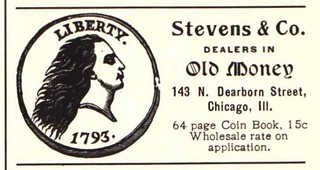
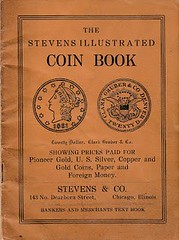
Silas Curtis Stevens is one of the hallowed old time coin, stamp and curio dealers. He ran a coin dealership and published a 32-page coin catalogue, which was expanded to 48 pages in 1906, and 64 pages in 1909. Those familiar with him in American numismatic history probably think of him much the same as I do, with a romantic view holding him in high esteem as one of the old time greats. He was one of the early full time dealers in Chicago starting his trade in coins, paper money, stamps and curios about 1877. Numismatic literature collectors are familiar with the old fixed price coin books he published with S. C. Stevens & Co., Chicago, Illinois printed on the front covers. We peruse these antiques with fondness and affection and impart the same sentiments to "old Stevens" thinking of the venerable dealer who died at age eighty-two with tender devotion as we would our own grandad. Most American numismatist will recall and agree with this very same term of endearment popularized by Farran Zerbe in his August 1906 essay in The Numismatist, "A Jaunt Across the Continent" where he calls Stevens "the grand-dad of the dealers". O, but how deceived we are! Research will show that concealed beneath his benevolent surface lies a man capable of willful corruption and criminal behavior. What emerges is a puzzling man, i.e., puzzling to us since he appears to have had two sides to him; on the one hand, he was always known to be kind, supportive, and gracious within the ANA; on the other, in his private life, a ruthless scam artist. What perplexes us most is that he never seems to have done these bad things to become rich as one might assume leaving us puzzled about his motives. Historians and archaeologists can only uncover facts and artifacts and attempt, the best they can, to reconstruct the context, lives, customs, cultures, communities, and behaviors based upon our current knowledge in order to bring the facts and artifacts to life with meaning and appreciation of what they are and represent. Silas Curtis Stevens is one of those people who surprise us and at times disappoints us since we see in him something better having far greater capability of worthy deeds than some of the things he had done. On closer examination we shall attempt to peer into the mind, heart and soul of Stevens in a sincere effort to learn what made him behave badly when he did. He was born near Dover, Maine, on October 21, 1837, son of Sylvanus (Sylvester) Boardman Stevens (1804-1870) and Rebecca Proctor Bunker (1802-1886). He was born into an old colonial American family with ancestors who fought in the Revolutionary War. During the Civil War he enlisted as a member of the Regiment, Chicago Board of Trade Battery, Light Artillery, in July 1862, and served as a private. He joined the militia at the outbreak of the Civil War and was assigned the post of chief-clerk for General Crook. Unwittingly, years later Stevens was to become a general crook himself. Nevertheless, in 1864, he was transferred to the same post under General Garrard. The following year he was detailed to General J. H. Wilson, Calvary Corp, Army of the Mississippi, as chief clerk for Major McBurney. After the surrender of Lee, he mustered out on July 1865. In 1877 he purportedly began business as a coin and stamp dealer. However, young Stevens also engaged in other less noble pursuits, one of them cheating and defrauding people out of their money. On October 24, 1878, he was one of the principals in a land scam. He and his partners sold land at a high price which turned out to be swamp land. In 1880 he formed a partnership with Louis F. Lindsay under the firm Stevens & Co., with offices at 30 Tribune Building, Chicago. Later the firm moved to 90 Randolph Street, Chicago. Since we know that is his address we also know that Randolph Street is the well-known auction store district of the Pawnbrokers. Consequently, we can infer that Stevens & Co., in the early years was a pawnbroker firm. The sale of coins sold at auction in 1881 reported to Frossard by Markus was most probably that held by Stevens himself. Sadly, this is another series of coin auction sales missed by numismatic historians. He applied for membership to the ANA in 1892 and is member no. 62. His name appears in the February 1892 issue of The Numismatist in list no. 14 as no. 364.

In the famous essay, "A Tour Among the Dealers," January 1895 issue of The Numismatist, page 11, we read : "Stevens & Co. are found on the third or fourth floor of a large office building in the business center. The Co. we have never seen, but Mr. Stevens is nearly always on deck entranced behind a line of counters and show cases with a big fire-proof [safe] on hand. He is a bearded philosopher of a social type and when stamps and coins and idiotic inquirers are not absorbing his time, is always ready to discuss finance, religion anarchism, or other weighty topic without gloves." In October 1916 Elmer Sears proposed to make Silas C. Stevens an Honorary Member of the ANA, and it was passed unanimously by Wayte Raymond, Henry Chapman Waldo Moore, Dr. George French, Howland Wood and other notables. In 1917 he was made a corresponding member of the Chicago Historical Society (CHS). He made several donations to the CHS including a pocket photo album containing nine photographs of his friends during the Civil War. He died on April 26, 1919, at his home in Chicago.
I don't recall where, but I believe I've read before about Stevens' various run-ins with the law over old banknotes. As a prominent dealer of the day he was in a position to purchase large hoards of obsolete currency. While worth relatively little to collectors at the time, there was money to be made in passing the notes off to unsuspecting people in the hinterlands. John's article includes several newspaper accounts of these shenanigans. See the complete article online for more information. But was Stevens an innocent party? He certainly felt he was in the clear: "He ended his reply to the chief of the Secret Service by politely telling him and his detectives that he would see them in a warmer climate before he would quit" the business. He was ultimately arrested after making a deal with an undercover agent expressly asking for "some 'stuff' that would pass for good money in the country." -Editor
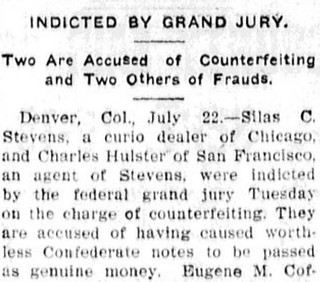
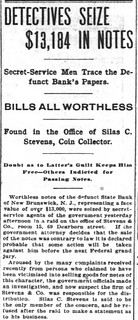
To read the complete article, see:
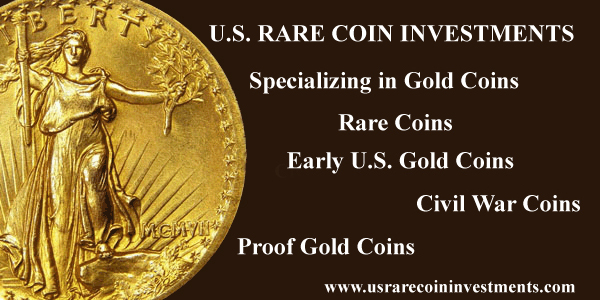
Wayne Homren, Editor The Numismatic Bibliomania Society is a non-profit organization promoting numismatic literature. See our web site at coinbooks.org. To submit items for publication in The E-Sylum, write to the Editor at this address: whomren@gmail.com To subscribe go to: https://my.binhost.com/lists/listinfo/esylum All Rights Reserved. NBS Home Page Contact the NBS webmaster 
|